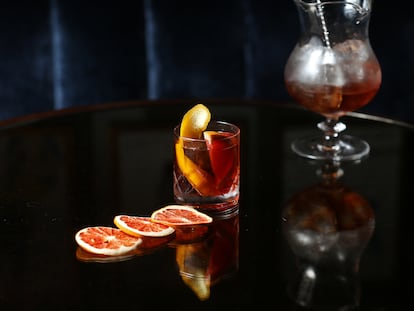Anything for a giant thermos: How Stanley Cups conquered the United States, from campouts to violent assaults
The 100-year-old brand’s mugs have become a trend over the past five years, with more than 10 million units sold and a sweeping presence on social media


It was tuberculosis and an oven that, some 111 years ago, led to the birth of what is now one of the most viral, sought-after, sold-out and resold products in the United States: a cup-bottle-thermos hybrid (called the Quencher) currently sweeping the country (and social media), causing massive lines in supermarkets, campouts and even robberies. Thanks to the phenomenon, their company has multiplied its sales by 10, powered by a growing desire to carry around a liter of hot coffee all day long.
To get a sense of this white-hot hype, one could enter into the tale at its climax. But to truly understand this story, one must start at the beginning. It commenced in 1913, when William Stanley Jr. started to work for General Electric, where he invented an oven. Although he lived in Pittsburgh, tuberculosis forced him to return north to Great Barrington, Massachusetts, where he had spent his youth living with his grandparents. There, he began to make camping and hiking excursions, and realized that he needed a good bottle to keep liquids hot or cold. Stanley applied his knowledge of steel, insulation and temperatures to the problem — the same knowledge that had allowed him to create the oven — and came up with a design for an insulating canteen, which he patented in August 1912. A year later, he registered a company and, according to local records, by 1924 was making between 800 and 900 thermos flasks a day. Good at inventing but bad at running businesses, he sold the company in 1933. In 2002, it passed into the hands of a Seattle-based multinational corporation, PMI.
This is when we arrive at the cups’ more recent history. The brand began to grow and put out more and more products, until in 2016, it saw the birth of its fateful Quencher, a 40-ounce, $45 cup with a lid and straw, whose base fits in cars’ cupholders. It was just another product at the time. But in 2020, along came Terence Reilly, who came on board as the president of PMI. Reilly was fresh from working at Crocs, the company responsible for those colorful (and in-demand, and increasingly trendy) plastic clogs. He had already learned how to convince the market of an object of desire. Looking for new outlets for PMI’s products, he discovered the website of a Utah-based blogger and marketer named Ashlee LeSueur, also known as The Buy Guy. LeSueur loved Quenchers, which were becoming increasingly hard to find. The two struck a deal, and Reilly sold her 10,000 of the thermoses for her to resell to her followers. She explained in an interview that this was “a huge risk,” “a mortgage,” given that it required her to invest all her savings. But her community caught on quickly, and she managed to sell the first 5,000 cups in four days. Another 5,000 were snapped up in a single hour. It was a revelation for both parties, who teamed up to develop more Quenchers. “Any brand on the planet that isn’t marketing to the 25-to-50-year-old woman is really missing the mark,” LeSueur said in an interview from a few months ago. 98% of her 180,000 followers are women.
Then, of course, Stanley was able to fly with its own wings. The company began to develop new colors (more than 100), special editions, personalized models, accessories for the cups (from keychains to cases). Sales have burgeoned. All this has meant stratospheric success for the company, which, according to The New York Times, grew by 275% percent between 2020 and 2021. CNBC, which was given exclusive access to the brand’s sales numbers, says that the company has sold more than 10 million Quenchers, to the tune of $73 million in 2020 and $750 million in 2023. Its vice president of global sales, Matt Navarro, told the publication Retail Dive that Stanley is the number one drinkware brand in North America, and that on TikTok there have been 700 million views of the hashtag #StanleyTumbler.
Its classic green cup is no longer the best-selling model, as it was just five years ago, and has ceded the throne to the brand’s giant thermos. Several factors have powered this shift. One has been the decision to focus on women, Millennials and Gen Z as a target audience, and the use of social media as the stage for this marketing. Nowadays, hundreds of Instagrammers and TikTokers recommend Stanley Cups to their friends and acquaintances. They are a hit among mothers, who say they don’t have time to refill a bottle, and who collect and accumulate new models as soon as they hit the market. Car culture, focused on what for many U.S. citizens serves as a second home, has also had an influence: according to AAA insurance, one of the largest of such companies in the world, in 2021, 92% of U.S. households owned a car and spent 61 minutes a day inside of it, while in 2017, the figure stood at 51%, and in 2014, 48%. People drink more and more bottled water (16 billion gallons a year), but disposable bottles have an increasingly sullied reputation, so refillable containers carry a certain caché. And then there’s the coffee industry, that of the country’s second most consumed beverage, which moves $81 billion a year — according to data from 2021 — with three out of four U.S. residents drinking it every day. The average individual expenditure on coffee is $200 a year.
@stanleybrand #stitch with @Danielle Stanley has your back ❤️
♬ original sound - Stanley 1913
And let’s not forget those two powerful months of virality, which were not designed by Stanley, but were certainly supported by it, and highly beneficial to the brand. The first took place in November 2023, when a U.S. woman named Danielle posted a video to her social media showing how her car had burnt to a crisp… save for the Stanley Cup that had been inside it, which had survived. 100 million people saw the clip, and the company’s CEO responded with a video offering her not only a new thermos, but also a new car, a tactic that led to even better market positioning. Dozens of commenters declared that they had bought Stanley products thanks to the two videos. In January, the real madness took hold when the brand released two editions (in pink and red, celebrating Valentine’s Day) in collaboration with Target. That they sold out is not the whole story, but rather, that they did so after consumers lined up to buy them, even camping outside store locations beginning the day before the release. As if over a new iPhone, in Starbucks locations that were also selling the cups, assaults were reported, and fights broke out. Target has fired employees for reselling the cups. From an original sticker price of $45, they have garnered $200, even $300 on eBay. The fever for the gigantic thermoses knows no limits.
Sign up for our weekly newsletter to get more English-language news coverage from EL PAÍS USA Edition
Tu suscripción se está usando en otro dispositivo
¿Quieres añadir otro usuario a tu suscripción?
Si continúas leyendo en este dispositivo, no se podrá leer en el otro.
FlechaTu suscripción se está usando en otro dispositivo y solo puedes acceder a EL PAÍS desde un dispositivo a la vez.
Si quieres compartir tu cuenta, cambia tu suscripción a la modalidad Premium, así podrás añadir otro usuario. Cada uno accederá con su propia cuenta de email, lo que os permitirá personalizar vuestra experiencia en EL PAÍS.
¿Tienes una suscripción de empresa? Accede aquí para contratar más cuentas.
En el caso de no saber quién está usando tu cuenta, te recomendamos cambiar tu contraseña aquí.
Si decides continuar compartiendo tu cuenta, este mensaje se mostrará en tu dispositivo y en el de la otra persona que está usando tu cuenta de forma indefinida, afectando a tu experiencia de lectura. Puedes consultar aquí los términos y condiciones de la suscripción digital.
More information
Archived In
Últimas noticias
Most viewed
- Sinaloa Cartel war is taking its toll on Los Chapitos
- Oona Chaplin: ‘I told James Cameron that I was living in a treehouse and starting a permaculture project with a friend’
- Reinhard Genzel, Nobel laureate in physics: ‘One-minute videos will never give you the truth’
- Why the price of coffee has skyrocketed: from Brazilian plantations to specialty coffee houses
- Silver prices are going crazy: This is what’s fueling the rally










































